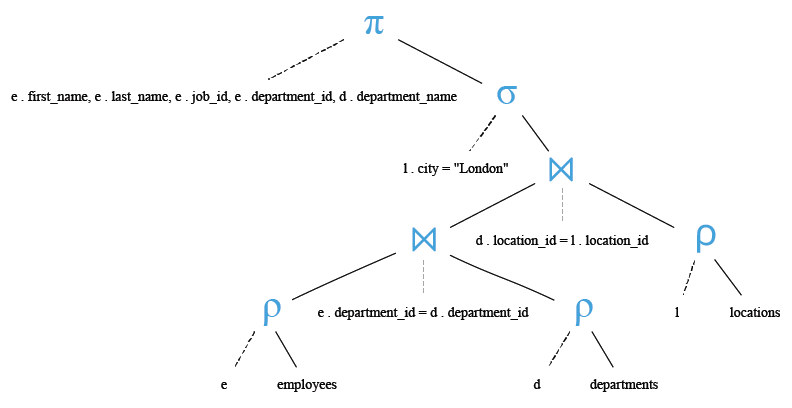PostgreSQL JOINS: Make a join with three tables to find the name, jobs, department name and ID of all the employees working in London
3. Write a SQL query to make a join with three tables employees, departments and locations to find the name, including first_name and last_name, jobs, department name and ID, of the employees working in London.
Sample Solution:
Code:
-- This SQL query retrieves employee details along with their department information for employees working in London.
SELECT e.first_name, -- Selects the first_name column from the employees table
e.last_name, -- Selects the last_name column from the employees table
e.job_id, -- Selects the job_id column from the employees table
e.department_id, -- Selects the department_id column from the employees table
d.department_name -- Selects the department_name column from the departments table
FROM employees e -- Specifies the first table from which to retrieve data, in this case, the employees table
JOIN departments d -- Joins the employees table with the departments table
ON (e.department_id = d.department_id) -- Specifies the join condition based on the department_id column
JOIN locations l ON -- Joins the departments table with the locations table
(d.location_id = l.location_id) -- Specifies the join condition based on the location_id column
WHERE l.city = 'London'; -- Filters the rows to include only those where the city is 'London'
Explanation:
- This SQL query retrieves employee details along with their department information for employees working in London.
- The SELECT statement selects the first name, last name, job ID, department ID, and department name columns.
- The FROM clause specifies the first table from which to retrieve data, which is the employees table, aliased as e.
- The JOIN keyword is used to join the employees table (e) with the departments table (d) based on the department_id column.
- The ON clause specifies the join condition based on the matching department_id.
- Another JOIN operation is performed to join the departments table (d) with the locations table (l) based on the location_id column.
- The WHERE clause filters the rows to include only those where the city is 'London'.
- The result set will contain employee details along with their department information for employees working in London.
Sample table: employees
Sample table: locations
Sample table: departments
Output:
pg_exercises-# FROM employees e pg_exercises-# JOIN departments d pg_exercises-# ON (e.department_id = d.department_id) pg_exercises-# JOIN locations l ON pg_exercises-# (d.location_id = l.location_id) pg_exercises-# WHERE l.city = 'London'; first_name | last_name | job_id | department_id | department_name ------------+-----------+--------+---------------+----------------- Susan | Mavris | HR_REP | 40 | Human Resources (1 row)
Relational Algebra Expression:

Relational Algebra Tree:

Go to:
PREV : Write a query to make a join with employees and departments table to find the name of the employee, including first_name and last name, department ID and name of departments.
NEXT : Write a query to make a join with two tables employees and itself to find the employee id, last_name as Employee along with their manager_id and last name as Manager.
Practice Online
Have another way to solve this solution? Contribute your code (and comments) through Disqus.
What is the difficulty level of this exercise?
